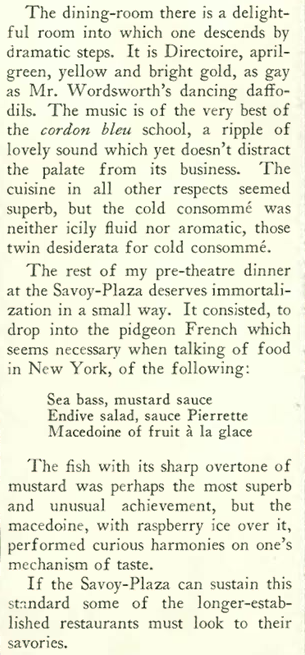Continuing to explore the Oct. 8, 1927 issue, The New Yorker editors were taking into account the rapid changes around the bustling heart of the city, Grand Central Terminal at 42nd Street and Park Avenue.

Their subject was the New York Central Building, which was slated to become the tallest structure in the great “Terminal City” complex.
The New Yorker commented that the new building would “remove a section from the sky.” Just 34 years later, in 1963, more sky would be removed when the massive Pan Am Building would open at 200 Park Avenue and dwarf the New York Central Building.

* * * * *
In the same issue The New Yorker lauded the opening of the Savoy-Plaza Hotel, which overlooked Central Park at Fifth Avenue and 59th Street.


Harry Black, the owner of the nearby Plaza Hotel, built the Savoy-Plaza on a site previously occupied by the old Savoy Hotel (built in 1890). The Savoy-Plaza, designed by McKim, Mead & White, was intended to serve as a newer and less stuffy companion to the older Plaza Hotel.
Lois Long paid a visit to the new Savoy-Plaza and offered these observations in Oct. 15 issue’s “Tables for Two”…
In 1958 the Savoy-Plaza was sold to Hilton Hotels and renamed the Savoy Hilton. Hilton sold the hotel to investors in May 1962. In August 1964, the hotel’s planned demolition was announced amid significant public outcry and protests. The hotel remained open during the 1964/1965 New York World’s Fair, but was demolished by early 1966. It was replaced in 1968 with the General Motors Building.

* * * * *
On Oct. 8, 1927 Lois Long revived her “Tables for Two” column after a summer hiatus. She had married her New Yorker colleague Peter Arno in August, and no doubt was returning from a honeymoon. Maintaining her ruse that she was single and possibly middle-aged and writing under her pen name, Lipstick, Long referred to her absence as a “vacation”…
And finally…in the Oct. 8 issue this advertisement from Saks appeared opposite “The Talk of the Town.” In those high times before the market crash some folks apparently had the means to to buy a Russian sable for prices ranging from $19,500 to $55,000–the equivalent range today would be roughly $261,000 to $735,000…
Next Time: Age of the Talkies…







